
The "Itinerant Sonorities" of Pirâmides de Cristal by João Pedro Oliveira
Helena Santana
As a piece for piano solo Pirâmides de Cristal allows us to broach problems in the variation of timbre in works for a single instrument, an issue which, in this case, is not a straightforward one where the use of different pedals and forms of attack, associated with different dynamics and phrasings, quickly gives rise to a wide spectrum of instrumental colors and colorations. The composer moreover derives an enormous richness of timbre through his harmonies: close or widely spaced, with placements in different registers of the instrument, they all acquire densities, shades, configurations, and ways manifesting and developing their particular space and time. These transformations of color and spatial/temporal form result from what will be called different "illuminations" or "hues" which become more or less intense depending upon their context. Realized inventively and even radically, these processes affect the work not only at the micro-structural level, but also at the level of its macro-structure as the composer varies not only the color or coloration of his harmonies, but also the tonality of the passages or sections of the work in which they are inserted.
Oliveira also utilizes in Pirâmides de Cristal a system of construction inspired by the geometry of fractals. As he notes, "a fractal is a type of structure which maintains certain properties, independent of the level (microscopic or macroscopic) at which we observe. For this reason, certain characteristics which are important in its global form are also found in the smallest details." (1)
The goal of this study will be to determine the form by which the composer transposes these notions into the musical domain, and into the particular elaboration of Pirâmides de Cristal in its timbral treatment of the instrument and its conception, transformation, superposition and variation of "itinerant" sonorities.
Pirâmides de Cristal
Musical gestures recur throughout Pirâmides de Cristal of variable complexity. As their distinctive characteristics undergo greater and lesser degrees of variation, they become recognizable to the ear in varrying degrees, giving the work its unique form and coherence and bestowing technical and organizational clarity. Although structurally identical, these gestures appear in different, and at times, opposite registers; thus a fairly diverse palette evolves of musical colors which develop, transform, oppose and dissolve in time and space, giving rise to the image which binds the work, of a crystal, in its ever-changing display of contours, lustres, and hues.
Shortly after the beginning of the work, in measure 9, the composer presents a rhythmic/harmonic element which we will encounter throughout the entire piece. It contains harmonies with different characteristics and densities originating from the basic materials of the work in the initial and final elements of the opening sequence of gestures in measures 1 to 3.

Example 1:
Pirâmides de Cristal mm. 1 - 4, 9 - 10.The first, less dense, but widely spaced and higher sonority persists through almost all of the second measure in a specific rhythm. This rhythm, involving the repetition of a duration which becomes longer each time, is extended in time, provoking a relaxation of tension. As it descends, this gesture is accompanied by a dynamic which reinforces its rhythmic characteristics (fp > ppp). Reappearing in measure 11, it is found nevertheless in a different dynamic and in a slower tempo q = 50, as opposed to the gesture in measure 9 at q = 69 (Example 2).

Example 2:
Pirâmides de Cristal sonorities mm. 9 and 11
In measure 25, the same gesture reappears, unraveling in an even slower tempo, q = 40. It is here more diffuse and less tense than in the initial gesture (m. 9). Harmonically we encounter a variation: the second harmony is texturally and timbrally denser from its greater number of tones. This is opposed to its expansion in musical time (q = 69, q = 50, q = 40), but at the same time necessitated by it since the slower repetitions of the harmony lose harmonics and tend to become more empty in sound, so in introducing more notes, the composer compensates for this tendency.
This gesture appears more or less identically in measure 245 but at a tempo of q = 54, and a dynamic of mp > ppp…p. Throughout the work, it appears several times, varied and transposed, and acquiring different timbres. In measure 38, a distinct harmony and rhythm create a different "luminosity" in the musical gesture; more marked in its (descending) melodic curve, we find here a greater level of rhythmic tension (see Example 3).
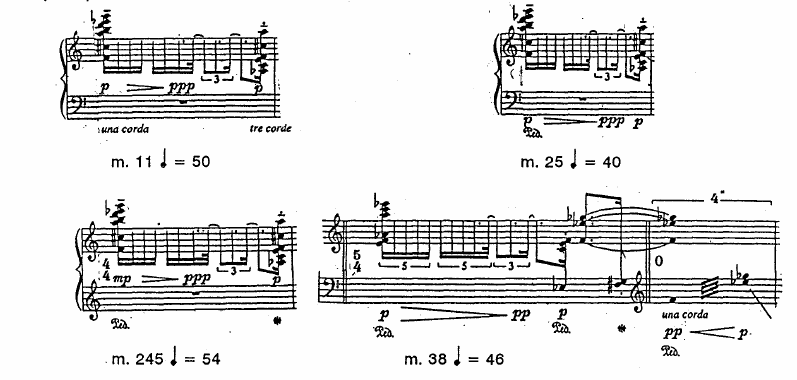
Example 3:
Pirâmides de Cristal mm. 11, 25, 245, 38.In its appearances in measures 211 and 239 we emphasize the fact that it occurs in different meters - 5/4 as opposed to 4/4 - and in distinct dynamics, although in measure 239 we encounter a new dynamic configuration: a crescendo followed by a decrescendo (ppp<p>pp). It even appears on the second beat of the measure, a weak beat; its luminosity and coloration change as it fluctuates in time and space. The gesture which is presented in measures 98 and 235 involving a more radical variation in its rhythmic/harmonic structure, maintains these essential structural characteristics; thus we include it in this family of gestures. It contains two distinct meters, 2/4 and 5/8, two dynamic configurations (mp > pp; mp > p - one for each measure), and is more dynamic and its circularity more accentuated (Example 4 ).
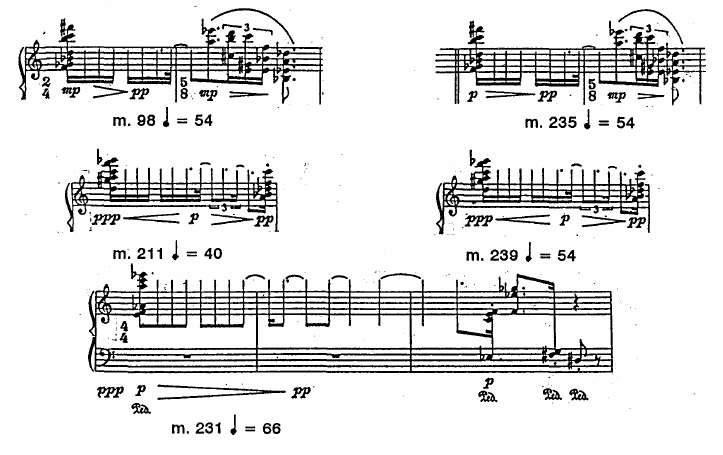
Example 4:
Pirâmides de Cristal mm. 98, 235, 211, 239, 231
The composer operates on the character, timbre and luminosity of the various musical elements at a second level in transforming the instrumental coloration and form of the work in rhythms of timbres. These rhythms control the appearance and development of the different surface features (characters and instrumental colors) from the same material. Thus the crystal and the cluster of light remain unchanged, creating spectrums of colors and different lustres, brilliant or somber, as the composer acts upon them through rotation, translation or inversion (giving directionality), angle, and intensity of projection. We encounter the same phenomena throughout the work in its color transformation and spatial and temporal development.
In measure 29 another gesture materializes, producing a new timbre with characteristics distinct from the preceding gesture; it possesses two sweeps, one ascending and another descending, its relaxed harmony diffused in time is quickly revealed to us. This gesture involves three moments - tension, calm , tension – which are reinforced by the dynamic - f > mp < sf – found repeatedly through Pirâmides de Cristal. Maintaining the same dynamic, (fff ), it is varied in measures 61, 150, and 159. The element of “pseudo” repose disappears, being realized each time in a more rapid and marked form as we can see in the metronomic indications used: ( q = 66; q = as fast as possible; q = as fast as possible. See Example 5).
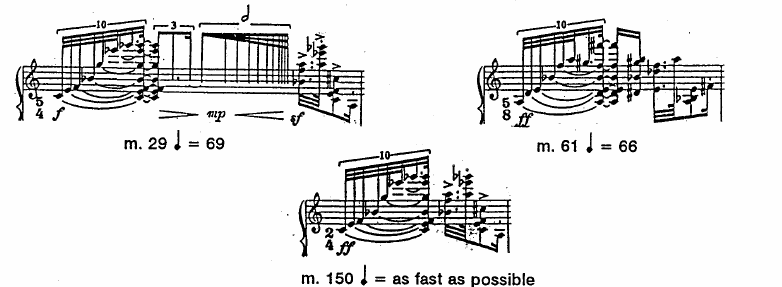
Example 5: Pirâmides de Cristal mm. 29, 61, 150
Another gesture which maintains some of the characteristics of the preceding ones is presented for the first time in measure 63. More dynamic, it unfolds in a successive form in space and time. Its harmony covers a large spectrum of the register of the instrument giving it a great sonorous and timbral density with unique timbral characteristics, and vivid colors, forms and developments which crystalize in new and distinct sounds. Rhythmically, it maintains the characteristics of the previous ones, but is rapid at the beginning while easing at the end. The dynamics reinforce this characteristic. The meter is maintained, conserving its strong and weak beats and its accentuations. The final form of the gesture is varied as a result of the three previous times that it is presented (mm. 63, 82, and 131).
Example 6: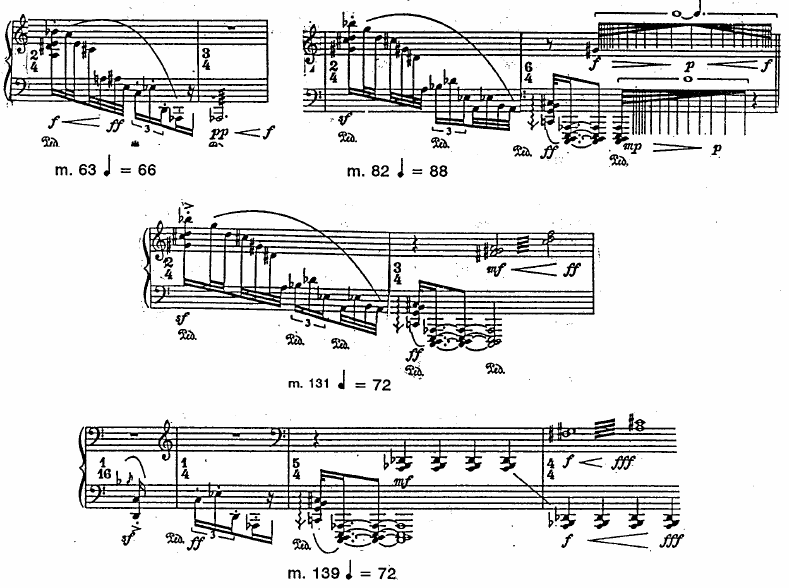
In the first
case, measure 63, it finishes in a long note in the low register of the
instrument which is repeated (rapid tremolo) in a dynamic which reinforces and
enlarges its sonority and thus its, timbre and luminosity. In measure 82, the
gesture appears in a higher register (transposed), the melodic descent being
more accentuated. The intervals are generally wider although the final ones are
realized more smoothly and the gesture ends in a sonority which appeared for the
first time in m. 68. Quite low and dense, it sharply accentuates the end of the
preceding gesture. The descending articulation of its harmonies (![]() ) reinforces the (extremely low) register of the sonority and its subsequent
repetitions. The latter are carried out in increasingly longer durations,
creating a melodic, rhythmic and harmonic relaxation, and reinforcing the
dynamic of this figure (mp > p ). In this measure,
the composer even superimposes a tremolo (G#3 - one of the tonal poles of the work)
articulated in a different manner from the gesture in the low register and taking a longer
duration with a contrary dynamic configuration (f > p < f ). These hues, in spite of their
common characteristics, develop in a differentiated manner, opposing each other and
providing mutual continuity and from the temporal point of view, we note the metronomic
indication of q
= 88 which is faster than the earlier appearance in m. 63 at
q = 66.
) reinforces the (extremely low) register of the sonority and its subsequent
repetitions. The latter are carried out in increasingly longer durations,
creating a melodic, rhythmic and harmonic relaxation, and reinforcing the
dynamic of this figure (mp > p ). In this measure,
the composer even superimposes a tremolo (G#3 - one of the tonal poles of the work)
articulated in a different manner from the gesture in the low register and taking a longer
duration with a contrary dynamic configuration (f > p < f ). These hues, in spite of their
common characteristics, develop in a differentiated manner, opposing each other and
providing mutual continuity and from the temporal point of view, we note the metronomic
indication of q
= 88 which is faster than the earlier appearance in m. 63 at
q = 66.
In measure 131 the previous gesture is repeated but it is used as an element of closure and its tremolo development is different. While denser, and of a different timbre, it is found nevertheless in the same register and on the tonal poles of C# and G# in the low register while adding another polarity in the middle register on F# (m. 132). In measures 139 - 141, the last of these gesture appears in which we can identify only the ending, but as it closes on a dense harmony repeated in the extreme low register, it reinforces the preceding appearances of the gesture. This steadily repeated low-register sonority reappears in measures 184 - 190, and 179 and 284 and possesses a darker, yet ecstatic nature which momentarily freezes and then loosens the exchange of ideas in preparation for the course of events to come.
Fractals
In measures 146 - 190 we encounter a section of the work which is elaborated according to the descending gestural sweep which we initially studied. It is in this manner that a system of construction inspired by the geometry of fractals is applied.
As a structure which maintains certain characteristics independently of the level of observation, we can make a parallelism with what happens over the entire musical work. The dominant characteristic of the gesture, its descending form, is represented here as a larger section of the work covering 44 measures and maintaining, albeit quite intricately, the characteristics of the initial gesture. In it we encounter three simultaneous sonorous planes:
the first constituted by the repetition of a sonorous pitch which varies from G#3 to A2 in
measure 153: C2 measure 170, D1 measure 178 and G#1 measure 181. We encounter, at
key points of the passage, the tonal poles of the work (G#, D#, D, G# - we emphasize that
the first is the same as the last).
the second constituted by the interpolation (return) of the preceding sonorous elements
the third constituted by harmonies which are articulated so as to create at a second level, a
static element but of distinct character and coloration with different compositional
consequences from the previous ones (Example 7 and 8).
We emphasize that in this section of the work the composer also uses interpolation. This is done in Example 8 using a typical harmony which is interjected five times always with a dynamic of sf and a meter of 1/16.
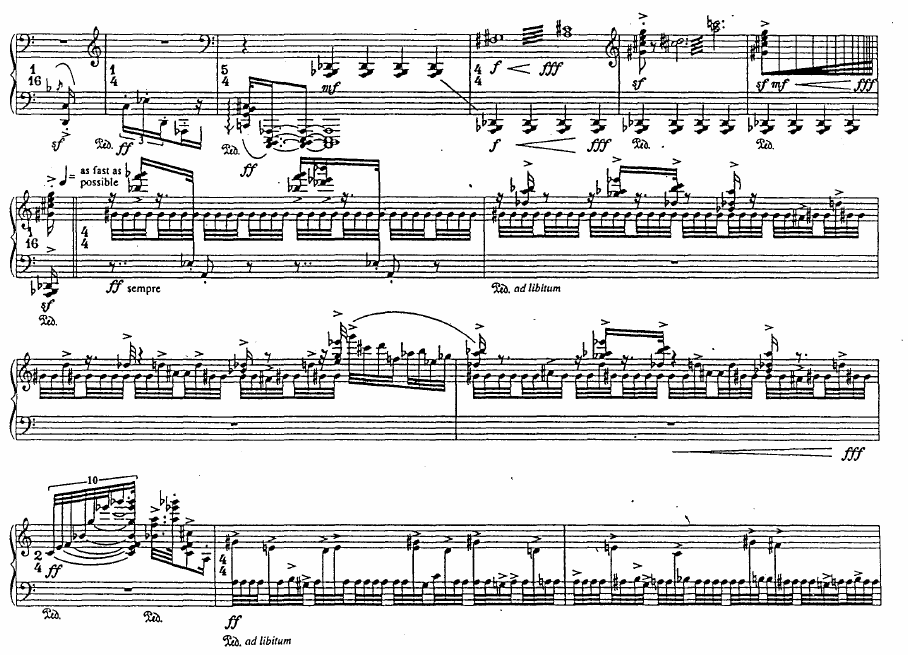
Example 7: Pirâmides de Cristal mm.145 - 152
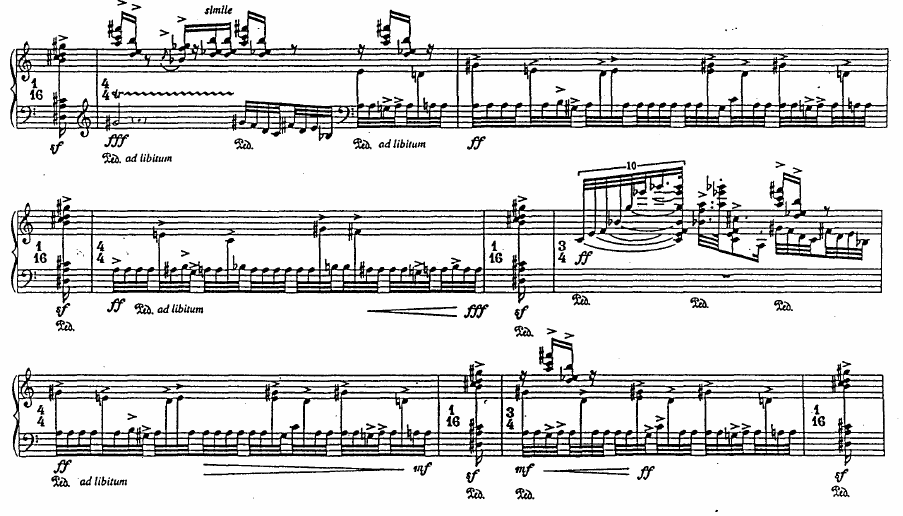
Example 8: Pirâmides de Cristal mm.153 - 163.
Interpolation
Beginning in measure 48 we note the process of interpolation of motives, harmonies, timbral objects or even more complex musical elements. This technique, used throughout the work, gives rise to the return of sonorities and previous musical elements, appealing to the memory of the listeners, and creating a unity within the diversity of materials of Pirâmides de Cristal. This process is revealed in measures 48 - 54 where we see a regular repetition (5 times) of a harmony which fixes the musical discourse in the mid-register in poles on D#2 and G#4. In the five times that it is used, this harmony maintains its structure independently of the different forms of attack, development and dynamic which provide an elaboration of the timbral elements of the sonority.
In the first case, this harmony appears arpeggiated, developing in a tremolo in the low register at a dynamic level of ppp < mp (Example 9).

Example 9:
Pirâmides de Cristal m. 48The second time it appears, it is also realized in an arpeggiated form and at a mp dynamic; taking however a shorter duration () and an accentuated articulation (-). (Example 10).
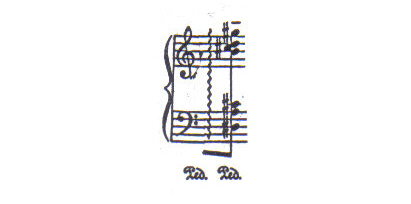
Example 10:
Pirâmides de Cristal m. 49
On the third time, it is used at mf in a staccato accentuado attack and in an ever shorter duration (x) (Example 11).

Example 11: Pirâmides de Cristal m. 49
Its fourth appearance is apreggiated pp , developing via a repeated tone (the highest note). (Example12).
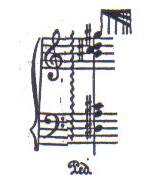
Example 12:
Pirâmides de Cristal m. 50
The last time that it is used it appears arpeggiated with a duration of , at mp as an ending of a gesture with different characteristics from the preceding ones (Example 13 - see also the summary of the previous occurrences of the gesture in mm. 48 - 54. in Example 14 below.)
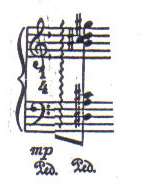
Example 13:
Pirâmides de Cristal m. 54
The objet sonore in question thus acquires distinct and well defined functions and timbres in the five times that it is used, polarizing the discourse in a restricted registral field. We note the use of short durations and contrasting dynamics which give emphasis to the particular dynamic of the section. Up to this moment, the musical gestures possess predominantely descending characteristics but from this moment they will be predominantly ascending.
We encounter interpolation in other moments of the work. Between measures 153 and 167 (see again Example 8 above), it is accomplished using the same the same harmonic object. Between measures 168 - 180 (Examples 15 and 16) it is realized with another harmony. We note that in these cases the duration, the dynamic, the form of attack and the meter are maintained throughout the entire process. Utilizing other materials we see that the process of interpolation is found even in measures 146 - 196.
in m. 148, interpolated material (varied) from measure 123.
in m. 150, interpolated material from measures 29
in m. 159, interpolated material from m. 29 (Examples 7, 8, and 14)
Interpolation brings the repetition and return of ideas, elements, objects, harmonies, timbres and instrumental colorations. It is accomplished through very strong elements and musical ideas, creating a second level of composition and perception. In appealing to musical memory, the differentiated timbres of these elements create planes and connecting threads within the work which delimit, encircle, stabilize its movement and internal diversity.
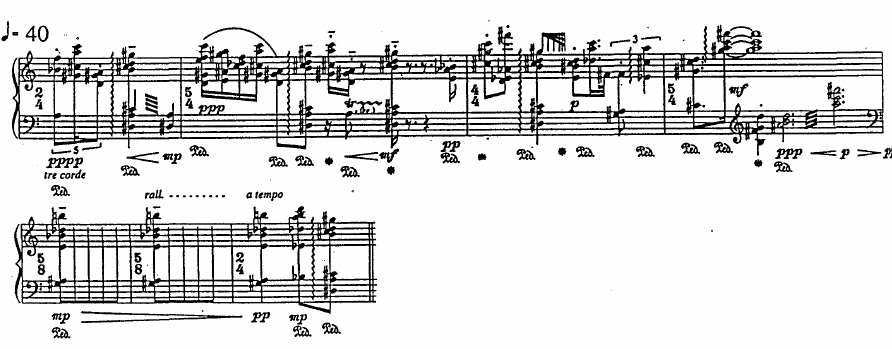
Example 14:
Pirâmides de Cristal mm.48 - 54
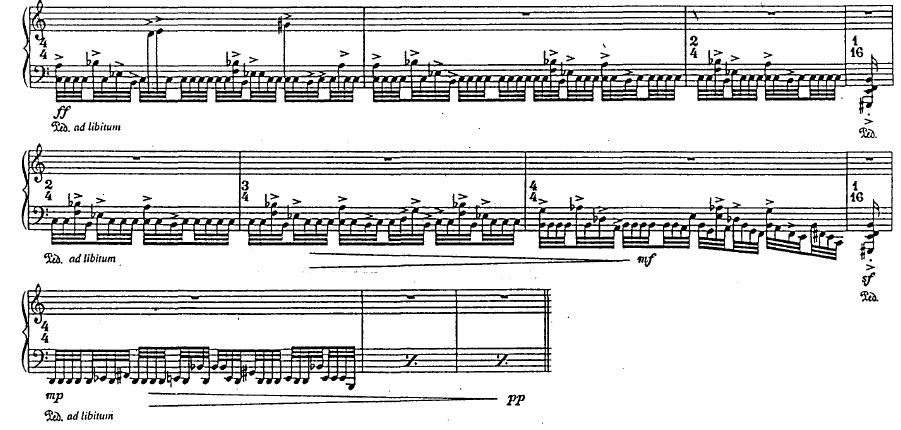
Example 15:
Pirâmides de Cristal sonorities in mm. 170 - 180.
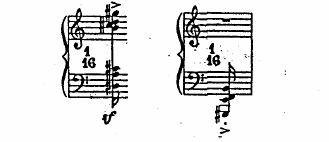
Example 16: Pirâmides de Cristal interpolated sonorities in mm. 153-167 and 168-180.
Textures
Through measures 111 to 138, a very complex texture develops on three planes which involve three distinct gestures. Occurring in the lower mid- to the high registers we find an arpeggiated harmony ending in F#5. The second gesture maintains the same characteristics on a different harmony. The third and fourth gestures also possess these characteristics but the third has the peculiarity of ending on G#5. (The gestures of this section which maintain these characteristics always end on the tonal poles of F#5 and G#5. See Example 17 and Figure 1).
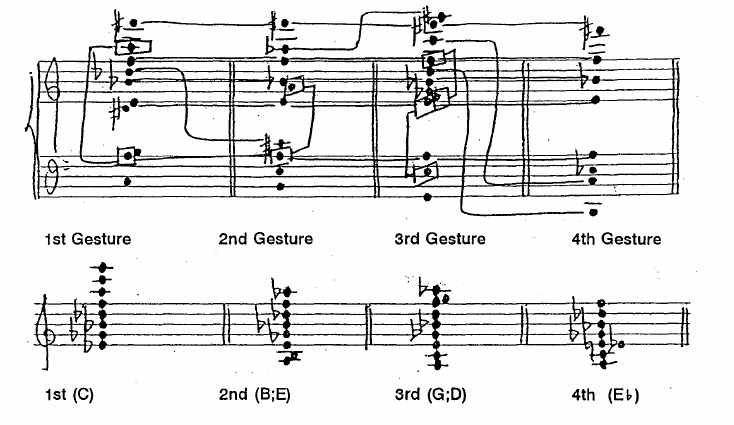
Figure 1:
Pirâmides de Cristal sonorities in mm.111, 112, 113, 114 The five constant notes between the four harmonies: A2, E3,B3, F4, F#5.We note however that the harmonies used do not differ much one from another but are rather transformed and developed through this passage creating shimmers, spectrums of colors, sonorities and distinctive resonances.
We find another sonorous plane in the low register. Static, the elements which compose it are:
2 harmonies (diminished 5th and major sixth)
one tone - G# - one of the tonal poles
short durations (eighths and sixteenths)
forms of attack -staccato and staccato accentuado dynamics
dynamics - f; ff and sf
From these opposing characteristics, this static sonorous plane creates a connecting thread and a field of polarization which contradicts the two dynamic forces of the other planes. We note that a third plane, occurring in the extreme low register has the following characteristics:
rapid repetition of a melodic pattern
rhythms of short durations
ascending and descending trills
static dynamics (p, mf ) and increasing dynamics (p < mf; mf < ff )
reduced ambitus - 10th and diminished 7th
the lowest note, F#1 is one of the tonal polarities

Example 17:
Pirâmides de Cristal mm.114-123

Example 18:
Pirâmides de Cristal mm.111, 19-20, 56, 72, 76, 78, 84, 90, and 92.This dynamic gesture does not have strongly ascending or descending characteristics. The melodic movement undulates within the ambitus of a 10th or a 7th.
From measures 114 we see a process of interpolation of elements used previously. We note that:
in measure 114 interpolated material (varied) from measure 12
in measure 121 interpolated material (varied) from measure 1
in measure 123 interpolated material similar to measures 73 or 82
in measure 131 interpolated material from measures 82 and 83, the latter varied
In this section we encounter the realization of three sonorous planes with different characters, sonorities and colorations, which are opposed and developed along a descending curve to the extreme low register (m.141). The fractal principle is applied equally here: the dominant characteristic of the initial gestures also determine the global form of the gesture of this section of Pirâmides de Cristal.
We emphasize that the material which composes the first gesture of measure 111, has its origin in measures 19-20, being reintroduced and varied in measures 56, 72, 76, 78, 84, 90 and 92 (Example 18 above).
The "Eternal Return" in Pirâmides de Cristal
The repetition, recurrence and return of different musical gestures occurs on an even more complex level at various moments of the work. Analyzing and comparing measures 5 - 9 and 19-23 we note strong similarities. Composed of two predominantly ascending gestures, each one of the passages maintains the same rhythmic characteristics but differing in dynamics, tempo and types of measures used, and thus creating a diversity in their consistency of rhythmic/melodic tension and harmonic material. (Example 19).

Example 19:
Pirâmides de Cristal mm. mm.5-9, 9 - 23If we compare measures 11-16 and 25-28, we find equally strong similarities. In this case, we find variation at the harmonic level (m. 26), timbral level (m. 26, 28), and temporal level (the first passage at •= 50, the second at •= 40, and •= 69, in m. 27). In the second case, there exists an acceleration which accentuates existing rhythmic, harmonic and melodic tensions. On the dynamic level we also find differences which accentuate the existing temporal acceleration (Example 20).

Example 20:
Pirâmides de Cristal mm. 11 - 16 , 25 - 28.The last gesture or gestural sequence to be presented undergoes a certain process of variation in rhythm, melody, harmony and dynamics. Its two linked occurrences run from measures 29 - 31 and from measures 32 - 35. The variation arises essentially at the head of the second occurrence (mm.32-33, Example 21).

Example 21: Pirâmides de Cristal mm. 29-31, 32 - 35
The return of sonorities and gestures happens, as we have already noted, in
a systematic manner in Pirâmides de Cristal . We will analyze three cases (Examples 23,
24, and 25) where the opening musical gesture (mm. 1-3) appears throughout the work,
acquiring a different luminosity each time it is presented. Well defined in harmony,
dynamics, and phrasing, this gesture has a structure based on a single aggregate which
appears in a circular form in space and time (Example 22).
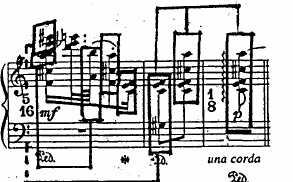
Example 22:
Pirâmides de Cristal mm. 1 - 3
In measures 42 to 45 (see Example 23) the process of variation is realized at
the beginning of the gesture. Introducing one measure (m. 42) the composer
retains the original circularity, not only in the development of the harmony but
also in its own form. We have here another fractal element; the principal of
circularity is applied as much to the principal of harmony as to its
development. The form of the gesture which it originates is equally structured
by this principle. Originally, the gesture possessed descending characteristics,
but in this case it takes the form of an arch (
![]() )
with the harmony and dynamics equally varied, conferring its own tonality and
brilliance.
)
with the harmony and dynamics equally varied, conferring its own tonality and
brilliance.
In measures 121, the composer introduces four elements to the initial gesture which alter its character (see Example 23):
the initial melodic motion
the fortissimo dynamic
the stabilizing element of the lower mid-register
the harmony, equally of the diminished fifth which
closes the gesture in the high register
The suppression of one of the inner harmonies precipitates the melodic motion to the low register (diminished 5th) in accentuation of its importance. It is noted in this case that the gesture is interpolated. In measure 226, we see a dynamic of p in connection with the end of the preceding gesture (Example 23).
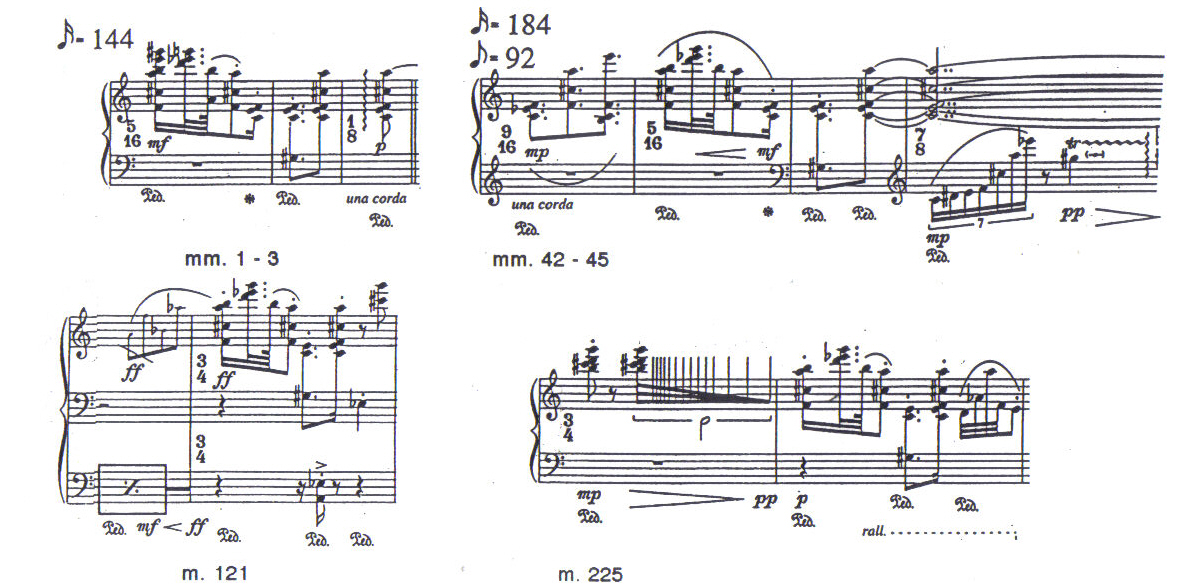
Example 23: Pirâmides de Cristal mm. 1 - 3, 42 - 45, 121 and 225.
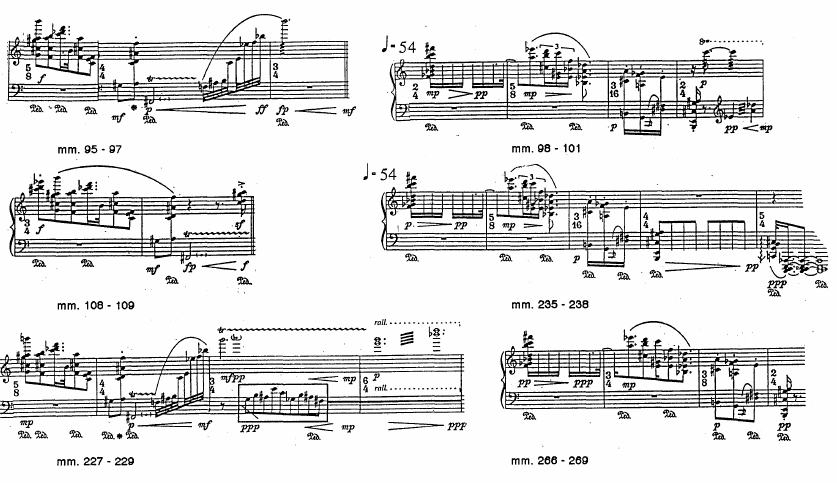
Example 24: Pirâmides de Cristal mm.95 - 97,108 - 109, 227 - 229 Example 25: Pirâmides de Cristal mm.98 -101, 235 - 269,
266 - 269
These same processes are found in the two further examples (see Examples 24 and 25 above):
the initial gesture of mm. 95 - 97, repeated in measures 108 - 109 and measures 227 - 229
the initial gesture, measures 98 - 101, repeated measures 235 - 238 and measures 266 - 269
Through the given examples, we have seen that these processes are used various times throughout the work. Circularity is applied globally to the formal structure of Pirâmides de Cristal, so there are "integral within its structure, various strongly polarized harmonic combinations on notes and specific intervals. These structures are used in a circular manner, repeating at different levels and moments of the work …." (2)
The combinatoriality, repetition and interaction in time and space of the harmonies, gestures and instrumental colors create a global circularity which controls its form, allowing more complex structural relations to be established between the different elements in the musical discourse. An economy of means is clearly in evidence as Pirâmides de Cristal, relies on a small reservoir of basic material which is used in a differentiated manner throughout the entire work, nevertheless without losing its governing structural characteristics, not only at the micro-structural but also at the macro-structural level. These characteristics, inherent in the geometry of fractals, are extrapolated to the higher compositional levels determining the form and global structure of the work, while at the same time, acting on the color, internal tension, "luminosity", and different characters of the material, the composer creates textures, sonorities, timbres, and diverse tensions which permeate the entire piece and confer a unique unity and coherence.
translation: John MacKay
1. liner notes to Numerica, P&C SPA recording NUM 1053 - Música Portuguesa sec. XX s.p.
2. liner notes to Numerica, P&C SPA recording NUM 1053 - Música Portuguesa sec. XX s.p.